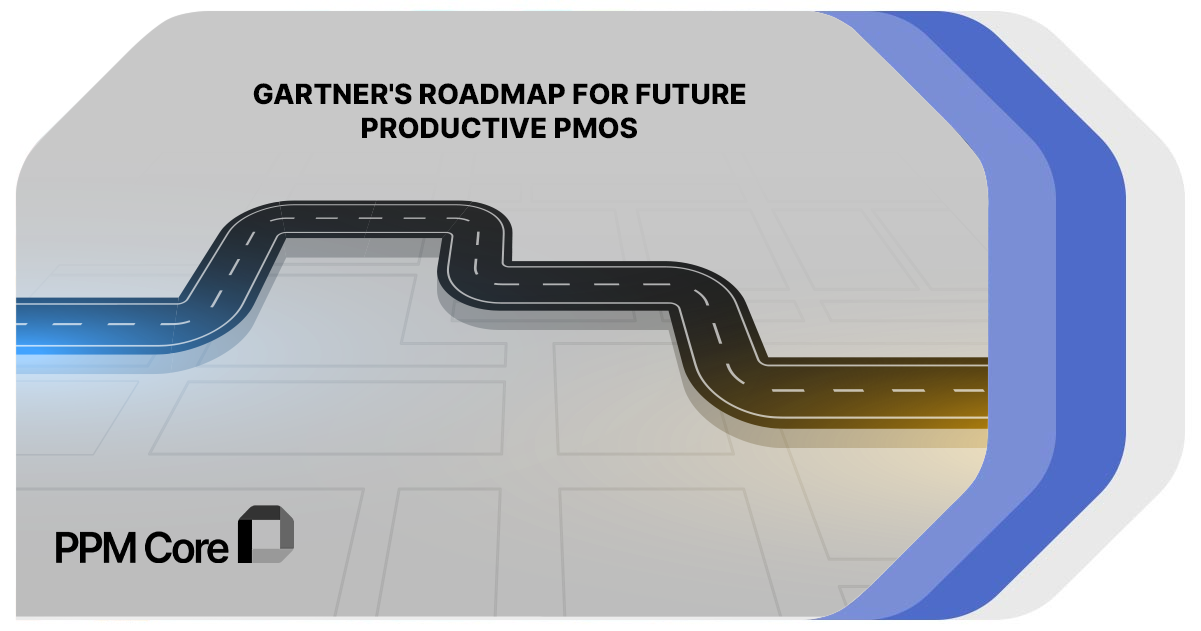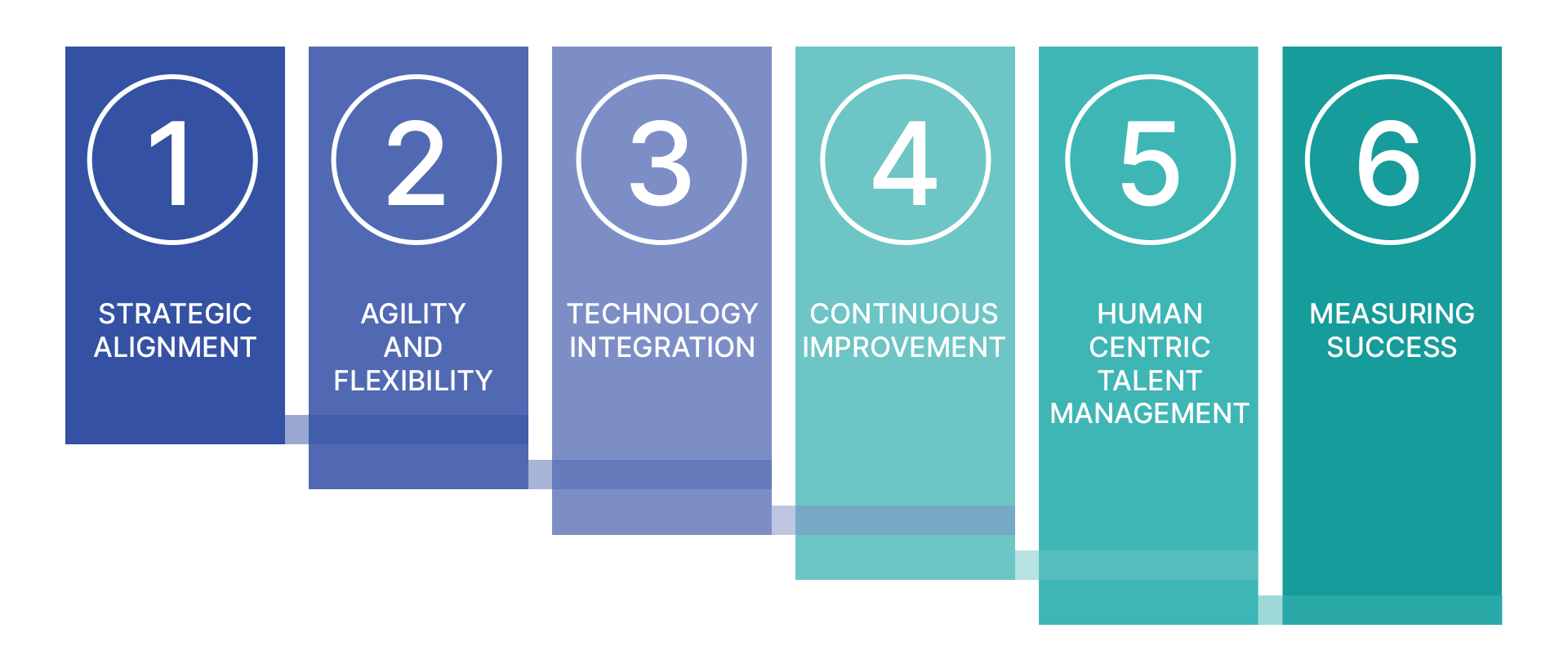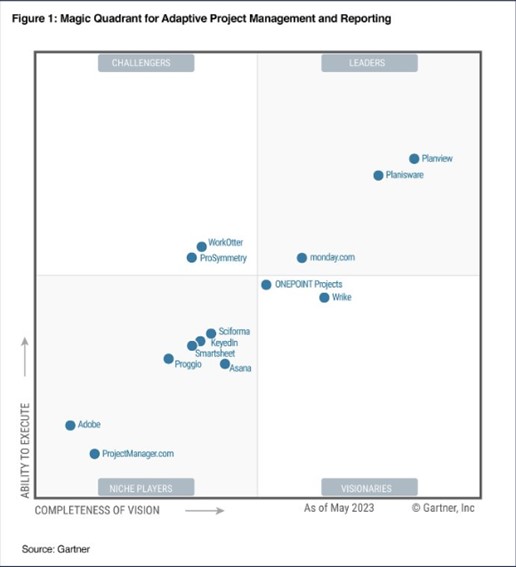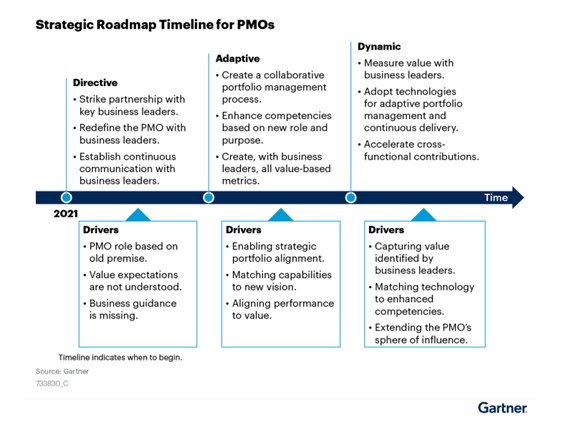An Inside Look at Gartner’s Roadmap
In the evolving business landscape, Project Management Offices (PMOs) play a crucial role in delivering projects that align with an organization’s broader goals, and Gartner has outlined a roadmap to help future-productive PMOs increase efficiency, enhance strategic alignment, and achieve success. This framework equips PMOs to navigate the complexities of modern business while adopting innovative technologies and methodologies.
Gartner’s roadmap emphasizes that PMOs must evolve in response to the dynamic business environment. By aligning with future trends, PMOs can enhance their productivity and ensure their relevance in the coming years. The roadmap is not just a set of guidelines; it represents a strategic shift that PMOs must adopt to maintain competitive advantages and support organizational growth.
Key Components of Gartner’s Roadmap for PMOs
To ensure long-term success, Gartner outlines several key components that PMOs must integrate into their operations. This roadmap is more than just a collection of ideas—it offers a comprehensive, actionable guide for PMO leaders seeking to align their project portfolios with the evolving demands of business environments. By embracing these components, PMOs can transition from being task-focused departments to strategic partners that drive organizational value and innovation. This shift is crucial for PMOs to not only survive but thrive in today’s competitive landscape, where technological disruption and changing business models constantly challenge the status quo.
Strategic Alignment
Strategic alignment refers to the process of ensuring that the PMO’s objectives are in sync with the organization’s broader business strategy. Gartner’s roadmap highlights the critical importance of this alignment to avoid project missteps that may lead to wasted resources or missed opportunities. For a PMO to succeed, it must focus on delivering projects that directly contribute to the organization’s key objectives.
This alignment involves regular communication with stakeholders, understanding organizational goals, and ensuring that project portfolios are prioritized based on their contribution to strategic initiatives. By fostering a clear line of sight between project outcomes and business objectives, PMOs can secure stakeholder buy-in and demonstrate value across the organization.
Technology Integration and Software Solutions
One of the cornerstones of Gartner’s roadmap is the integration of emerging technologies. In today’s digital age, technology is the driving force behind operational efficiency. PMOs must adopt robust software solutions and tools that automate manual processes, streamline project management tasks, and facilitate better collaboration.
Gartner recommends that PMOs focus on leveraging artificial intelligence (AI), machine learning (ML), and automation tools to improve productivity. These technologies can enhance decision-making, predict project risks, and ensure that resources are allocated effectively. By incorporating cloud-based project management tools and other digital solutions, PMOs can improve transparency and enable remote work capabilities, making them more adaptable to changing business conditions.
Here is a list of top 10 recommendations of software tools for improving PMO productivity:
1.Microsoft Project Online

Microsoft Project Online remains a leading solution for project and portfolio management (PPM). With features that allow teams to plan, prioritize, and manage resources effectively, it offers robust integration with other Microsoft tools like Teams and Power BI, providing seamless communication and data insights. The platform supports both traditional and agile project methodologies, making it adaptable to a variety of workflows.
2.Smartsheet

Smartsheet is a versatile work execution platform that is widely used by PMOs to manage large-scale projects and portfolios. It offers customizable templates, workflow automation, and real-time visibility into project performance through dashboards. Smartsheet’s integrations with other major software tools like Jira and Slack make it a preferred choice for collaborative project management.
3.Jira Align

For PMOs focusing on agile transformation, Jira Align is one of the top choices recommended by Gartner. This tool is designed to help organizations scale their agile processes, linking strategy to technical execution. It allows for real-time reporting, visibility across multiple teams, and alignment of work with corporate objectives. Jira Align is especially useful for large enterprises with complex project portfolios.
4.Planview Enterprise One
Planview Enterprise One is another comprehensive platform highly recommended for strategic portfolio management. It excels in helping PMOs manage resource capacity, prioritize work, and execute against business goals. With advanced analytics, scenario planning, and agile capabilities, Planview enables organizations to align projects with strategic objectives while maximizing resource utilization.
5.Wrike
Wrike offers a robust project management solution that includes task management, collaboration tools, and real-time reporting features. Its user-friendly interface allows teams to quickly adapt to the platform, and its automation capabilities reduce the time spent on manual tasks. Wrike’s ability to integrate with other tools such as Salesforce and Google Workspace makes it a flexible solution for many PMOs.
6.Clarity by Broadcom

Broadcom Clarity is an all-in-one project and portfolio management solution that has numerous use cases across multiple industries. Users have been able to streamline workflows and improve the overall efficiency of their operations, leading to better strategic decision-making. With Clarity, users can process payroll in-house, resulting in a faster turnaround time for payroll processing days. This solves the problem of delayed payments and improves employee satisfaction.
7.GanttPro

Unlike other kinds of work management tools or collaboration apps, project management software almost always has a Gantt chart view that shows you how all tasks in a project come together to get you to the end result. GanttPro is one such app, as you might guess from the name. Since its 2015 debut, GanttPro has grown into one of the top options on the market. It’s best suited to small businesses that need a project management platform that’s easy to use and priced affordably. It doesn’t have a ton of extras, such as reports or invoicing tools, though it does offer basic budget tracking. Because it has everything a small business would want, GanttPro is an Editors’ Choice winner.
8.Adobe Workfront
Adobe Workfront is a comprehensive solution for project management software that facilitates workflow, allows teams to create and collaborate on projects, and manages documents efficiently. It primarily serves medium to large businesses seeking robust project portfolios and workflow management tools.
The benefits of Workfront include streamlined project progression, enhanced visibility across tasks, and improved coordination within complex environments. It addresses common pain points such as disorganized workflow, scattered document management, and challenges in maintaining project portfolio visibility. Standout features include customizable dashboards, real-time collaboration capabilities, and advanced reporting functions.
9.ServiceNow
ServiceNow Strategic Portfolio Management is a highly regarded value-added Portfolio Management solution and also a top-ranked Enterprise Agile Planning tool. Strategic Portfolio Management (SPM) relates to the tools and processes that business organizations utilize to manage their usable resources and satisfy calculated business objectives.
10.Monday

Monday.com is a cloud-based project and work management platform geared towards planning and managing projects and tracking day-to-day workplace activities, tasks, and duties.
As tools for project management go, it’s extremely easy to use, with a clean interface, helpful instructions, and intuitive tools that don’t take long to master.
It also has a wide range of advanced features, like a workload view for keeping a close eye on your project’s progress and team duties, and one of the best dashboard builders in the industry.
PPM Core
While not officially on the Gartner PPM tool list, PPM Core is a relatively new PPM tool, launched in 2022 and developed by Synami, a company with a proven track record and two decades of experience in delivering software product innovations in the field of project management.
PPM Core is a cloud-based project and portfolio management platform that connects all project participants and unites all project data to provide a “Single source of truth: and empower seamless collaboration across teams, companies, and projects.
The software is designed to support project-oriented companies in overcoming today’s challenges related to managing projects of different sizes with multiple different project participants, where efficient communication and consolidated data is required more than ever.
To learn more about PPM Core, you can request a personal online demo presentation with a representative from the team.
Data-Driven Decision Making
Data is now central to every business function, and project management is no exception. Gartner underscores the importance of data-driven decision-making within PMOs. With access to real-time data analytics, PMOs can make informed decisions, identify trends, and assess the performance of ongoing projects.
By utilizing analytics dashboards, PMOs can monitor key metrics such as project timelines, budgets, and resource allocation, helping project managers to make adjustments quickly. This approach reduces the risk of project delays, cost overruns, and miscommunication. Furthermore, data-driven insights can improve the accuracy of future project forecasting and resource planning, leading to more predictable and successful project outcomes.
Adapting to Changing Business Environments
In a business environment that is constantly shifting due to market dynamics, technological advancements, and competitive pressures, PMOs must transition from static operational hubs to flexible, adaptive entities. Embracing agility means adopting a mindset that allows for rapid responses to changing priorities and unpredictable challenges. Simultaneously, continuous improvement becomes a critical driver of sustainable success, where PMOs regularly assess and refine their processes, tools, and strategies to optimize performance. This dual approach—balancing agility with a commitment to iterative enhancement—enables PMOs to stay aligned with business goals, drive innovation, and remain resilient in the face of volatility. In doing so, they ensure not only survival but also growth in a world where adaptability is the key to success.
Now, let’s delve deeper into how PMOs can specifically embrace agility and flexibility as integral parts of their strategic framework.

Do you find this article interesting?
Subscribe to our Newsletter for updates on the latest blog articles.
Agility and Flexibility
Agility is a critical factor in Gartner’s roadmap, encouraging PMOs to adopt flexible practices that allow them to pivot quickly when confronted with changing circumstances. Agile methodologies, which prioritize iterative progress, collaboration, and responsiveness, are becoming essential in today’s fast-paced business world.
For PMOs, adopting agile frameworks allows for greater flexibility in managing projects, enabling teams to adjust scope, timelines, and deliverables in response to evolving business needs. This flexibility ensures that projects remain relevant and aligned with organizational goals, even in the face of unforeseen challenges.
Continuous Improvement
Gartner’s roadmap also emphasizes the importance of continuous improvement in PMO operations. PMOs must regularly evaluate their processes, identify inefficiencies, and implement changes to improve project outcomes. By fostering a culture of continuous learning and improvement, PMOs can stay ahead of industry trends and maintain high levels of performance.
Regular assessments, employee training, and performance reviews can all contribute to this continuous improvement cycle. In addition, using feedback from completed projects to refine methodologies and processes helps PMOs optimize their operations and better serve their organizations.
Implementing Gartner’s Recommendations
The roadmap provided by Gartner is not just a high-level framework meant for theoretical discussions; rather, it is a practical guide that PMOs can use to drive real transformation and productivity. It takes into account the complexities and evolving nature of modern project management and offers concrete steps that PMOs can follow to improve performance and align with business goals. For PMOs looking to remain relevant and competitive, it’s crucial to translate strategic vision into actionable, measurable outcomes. This means understanding the roadmap as a dynamic tool for guiding decision-making and day-to-day operations. By implementing these recommendations, PMOs can gradually shift from reactive, task-oriented entities to proactive, strategic partners within their organizations.
The roadmap provides a pathway to achieve this through short-term wins, such as technology audits and portfolio alignment, as well as long-term strategies that include fostering continuous improvement and leveraging data-driven insights. This ensures PMOs are not only responsive to the immediate needs of the business but also poised to meet future challenges and opportunities.
For PMOs to effectively implement Gartner’s roadmap and become future-productive, it is essential to translate high-level strategies into actionable steps. The journey from strategic alignment to fully integrated technology systems requires clear, practical actions that can be undertaken both in the short and long term. These steps will not only help PMOs to address immediate operational challenges but also build a robust foundation for sustained growth and agility. By breaking down the roadmap into manageable actions, PMOs can gradually evolve from their traditional roles into dynamic, value-driven entities that directly contribute to the overall success of the organization.
Here’s how PMOs can approach this transformation:
- Short-term actions include conducting an audit of existing project management tools, identifying gaps in technology integration, and aligning current project portfolios with organizational goals.
- Long-term actions involve investing in emerging technologies such as AI and data analytics tools, training project managers in agile methodologies, and building a culture of continuous improvement through regular process reviews and employee development programs.
These steps, when executed methodically, will help PMOs transition into more agile, tech-enabled units that can respond effectively to both current and future business demands.
By breaking down Gartner’s roadmap into these practical steps, PMOs can start to make tangible improvements in their operations.
Case Studies and Examples
Several organizations have already seen success by applying Gartner’s strategies. For instance, a multinational corporation improved its project delivery timelines by integrating AI-powered project management software. By automating routine tasks such as scheduling and resource allocation, the company was able to free up its project managers to focus on higher-value activities, ultimately boosting productivity.
Another example is a mid-sized company that adopted agile methodologies to respond more effectively to market changes. By implementing agile sprints and cross-functional teams, they reduced project lead times by 20% and improved stakeholder satisfaction.
Measuring Success and ROI
In today’s data-driven business world, simply implementing a roadmap isn’t enough—success must be quantified and validated. For PMOs adopting Gartner’s roadmap, measuring success and return on investment (ROI) is crucial in demonstrating the effectiveness of the changes made and securing continued support from leadership. Success in this context goes beyond the completion of projects; it involves tracking how well PMO initiatives align with strategic objectives, how efficiently resources are used, and how effectively risk is managed.
By establishing clear key performance indicators (KPIs) that reflect both quantitative results, like cost savings and time-to-market improvements, and qualitative outcomes, such as stakeholder satisfaction, PMOs can comprehensively assess the value they are generating. This ability to measure and communicate results not only helps fine-tune PMO strategies but also ensures they remain aligned with evolving business goals. The connection between these performance metrics and continuous improvement efforts further cements the PMO’s role as a strategic partner in driving organizational success.
Metrics and KPIs
To evaluate the success of their initiatives, PMOs should focus on key performance indicators (KPIs) such as project completion rates, budget adherence, and stakeholder satisfaction. Gartner recommends tracking both quantitative metrics (such as cost savings and time-to-market) and qualitative feedback from stakeholders to get a comprehensive view of performance.
ROI Assessment
Assessing the return on investment (ROI) from adopting Gartner’s roadmap is essential to justify the changes made. PMOs can measure ROI by comparing the cost of implementing new technologies and processes against the benefits realized, such as improved project efficiency, reduced risk, and enhanced strategic alignment.
By regularly assessing ROI, PMOs can fine-tune their strategies and continue to demonstrate value to the organization.
Top Trends, Challenges, and Recommendations for Future-Productive PMOs
As PMOs evolve to meet the increasing complexities of modern business, staying ahead of key industry trends is no longer just advantageous—it’s essential for survival and growth. PMOs today must be more than operational hubs; they need to be strategic leaders that can adapt to shifting demands, from digital transformation to evolving workforce dynamics. Awareness and adaptability to these trends allow PMOs to maintain their role as central drivers of organizational success. By continually monitoring trends in work alignment, talent management, and technology, PMOs can anticipate potential challenges and proactively implement solutions that ensure long-term relevance and value. These trends serve not only as indicators of where the industry is headed but also as opportunities for PMOs to optimize their processes, align with corporate objectives, and foster innovation.
To remain effective, PMOs must stay aligned with the latest trends shaping the industry. First, work alignment is crucial, ensuring that every project directly supports the broader business objectives, thereby allowing the PMO to clearly demonstrate its value and contributions to organizational success. This alignment ensures that resources are focused on projects that drive the most impact.
Second, talent management is key to sustaining project success. It involves not only recruiting and retaining skilled project managers but also developing their ability to navigate both traditional and agile methodologies. This versatility enables the PMO to handle a variety of project types, from linear to more iterative frameworks.
Finally, staying ahead in technology solutions is vital. PMOs must adopt cutting-edge tools, such as artificial intelligence, automation, and cloud-based platforms, to improve efficiency, enhance competitiveness, and streamline project management processes. These tools are transforming how PMOs operate, allowing for better decision-making and productivity.
The increasing complexity of projects, coupled with resource limitations, demands a proactive approach to both daily management and future-oriented planning. By leveraging Gartner’s roadmap, PMOs can successfully navigate these challenges, driving both immediate results and sustainable growth for the organization.
Conclusion: The Path to Long-Term Success
It’s important to recognize that Gartner’s guidance goes far beyond abstract strategies. The roadmap for 2023 and beyond emphasizes actionable steps and transformative shifts in how PMOs should operate to maintain relevance and productivity in increasingly complex environments. Gartner suggests that PMOs must evolve from being process-driven entities to strategic enablers that focus on creating business value through agility, technology adoption, and data-driven decision-making.
A key takeaway from Gartner’s latest insights is the focus on adaptive project management and reporting. This approach highlights the necessity for PMOs to be not only reactive to changes but also proactive in anticipating future needs by leveraging advanced portfolio management tools, such as AI and predictive analytics, to align with organizational goals. Furthermore, Gartner emphasizes strategic portfolio management (SPM), which allows PMOs to prioritize initiatives that drive business outcomes, ensuring resources are allocated to the most impactful projects.
Another critical aspect is Gartner’s recommendation to foster a human-centric approach, acknowledging that talent management is just as important as technological tools. The roadmap encourages PMOs to develop a workforce skilled in both traditional and agile methodologies to drive innovation and maintain alignment with long-term business strategies.
In conclusion, Gartner’s roadmap is a forward-thinking, practical guide that underscores the importance of agility, technology integration, and human capital management. PMOs that follow these recommendations are better positioned to navigate the future, ensuring they deliver both strategic value and operational excellence.




